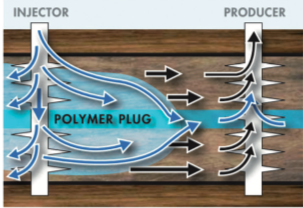
Published 2018-12-17
Keywords
- Conformance, sweep efficiency, reservoir heterogeneity, flood efficiency, oil recovery factor, oil response, breakthrough, bulk gel, design considerations, channel volume, treatment slug volume, candidate screening selection, placement strategies, bulk gel polymer concentration, field application, lesson learned
How to Cite
Copyright (c) 2018 Revista Fuentes

This work is licensed under a Creative Commons Attribution 4.0 International License.
Abstract
Conformance improvement is commonly referred to as the action of improving the drive-fluid sweep efficiency during an oil- recovery flooding operation. This technical note highlights the authors lessons learned during the field application of one of the most widely used and quite successful conformance technologies, which is Cr(III)-carboxylate/acrylamide-polymer (CC/AP). To date, the authors have been involved in the analysis, candidate selection, design, field application and post-treatment evaluation of ±700 injection well treatments over the last 25 years. A look back to the earliest treatment designs and field applications as compared to the more recent applications, clearly shows that we have made advancements to achieve better and more consistent results. These changes have occurred gradually over time as new lessons learned are continuously applied to improve treatment strategies and results.
Downloads
References
Díaz, R. J., Navarro, S. F. M., & Tavera, C. P. S. (2007). Modelo estadístico para la realización de analogías orientadas a procesos de recobro mejorado. Revista Fuentes, 5(1). https:// revistas.uis.edu.co/index.php/revistafuentes/ article/view/421.
Hernandez, F. A. T. (2018). Effects of salts and temperature on rheological and viscoelastic behavior of low molecular weight HPAM solutions. Revista Fuentes, 16(1), 19-35.
Maya, G., Castro, R., Sandoval, J., Jimenez, R., Pinto, K., Diaz, V., Zapata, J., Perdomo, L. & Muñoz, S. Successful Polymer Gels Application in a Highly Channeled Peripheral Injection Well: Tello Field Pilot (SPE-169478). Latin American & Caribbean Petroleum Engineering Conference, Maracaibo, Venezuela, May 21- 23, 2014.
Molano, A. M. J., Navarro, S. F. M., & Díaz, R. J. (2014). Metodología para el diseño de baches en un proceso de inyección de polímeros para recobro mejorado, considerando fenómenos de interacción roca/fluidos. Fuentes: El reventón energético, 12(2), 6.
Pinto, M. S., Herrera, D. M., & Angarita, J. C. G. (2018). Production optimization for a conceptual model through combined use of polymer flooding and intelligent well technology under uncertainties. Revista Fuentes, 16(1), 37-45.
Sydansk, R. & Smith, T. Marathon Oil Co. Field Testing of a New Conformance-Improvement- Treatment Chromium(lll) Gel Technology (SPE/DOE 17383). Enhanced Oil Recovery Symposium, Tulsa, Oklahoma, April 17-20, 1988.
Sydansk, R. & Southwell, G. 1998. More than 12 Years’ Experience with a Successful Conformance Control Polymer-Gel Technology (SPE 49315). SPE Annual Technical Conference and Exhibition, New Orleans September 1998.
Velandia, J. L. P. (2013). Simulación numérica del flujo bifásico agua-petróleo en un medio poroso. Fuentes: El reventón energético, 11(2), 10. https://revistas.uis.edu.co/index.php/ revistafuentes/article/view/3837.